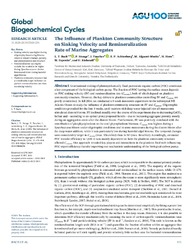The Influence of Plankton Community Structure on Sinking Velocity and Remineralization Rate of Marine Aggregates
Stange, P.
Achterberg, E. P.
Algueró-Muñiz, M.
Horn, H.
Esposito, M.
DOI: https://doi.org/10.1029/2019GB006256
Persistent URL: http://resolver.sub.uni-goettingen.de/purl?gldocs-11858/9472
Persistent URL: http://resolver.sub.uni-goettingen.de/purl?gldocs-11858/9472
Bach, L. T.; Stange, P.; Taucher, J.; Achterberg, E. P.; Algueró-Muñiz, M.; Horn, H.; Esposito, M.; Riebesell, U., 2019: The Influence of Plankton Community Structure on Sinking Velocity and Remineralization Rate of Marine Aggregates. In: Global Biogeochemical Cycles, Band 33, 8: 971 - 994, DOI: 10.1029/2019GB006256.
 |
Dokument öffnen: |
Gravitational sinking of photosynthetically fixed particulate organic carbon (POC) constitutes a key component of the biological carbon pump. The fraction of POC leaving the surface ocean depends on POC sinking velocity (SV) and remineralization rate (Cremin), both of which depend on plankton community structure. However, the key drivers in plankton communities controlling SV and Cremin are poorly constrained. In fall 2014, we conducted a 6-week mesocosm experiment in the subtropical NE Atlantic Ocean to study the influence of plankton community structure on SV and Cremin. Oligotrophic conditions prevailed for the first 3 weeks, until nutrient-rich deep water injected into all mesocosms stimulated diatom blooms. SV declined steadily over the course of the experiment due to decreasing CaCO3 ballast and—according to an optical proxy proposed herein—due to increasing aggregate porosity mostly during an aggregation event after the diatom bloom. Furthermore, SV was positively correlated with the contribution of picophytoplankton to the total phytoplankton biomass. Cremin was highest during a Synechococcus bloom under oligotrophic conditions and in some mesocosms during the diatom bloom after the deep water addition, while it was particularly low during harmful algal blooms. The temporal changes were considerably larger in Cremin (max. fifteenfold) than in SV (max. threefold). Accordingly, estimated POC transfer efficiency to 1,000 m was mainly dependent on how the plankton community structure affected Cremin. Our approach revealed key players and interactions in the plankton food web influencing POC export efficiency thereby improving our mechanistic understanding of the biological carbon pump.
Statistik:
ZugriffsstatistikSammlung:
This is an open access article under the terms of the Creative Commons Attribution License, which permits use, distribution and reproduction in any medium, provided the original work is properly cited.

